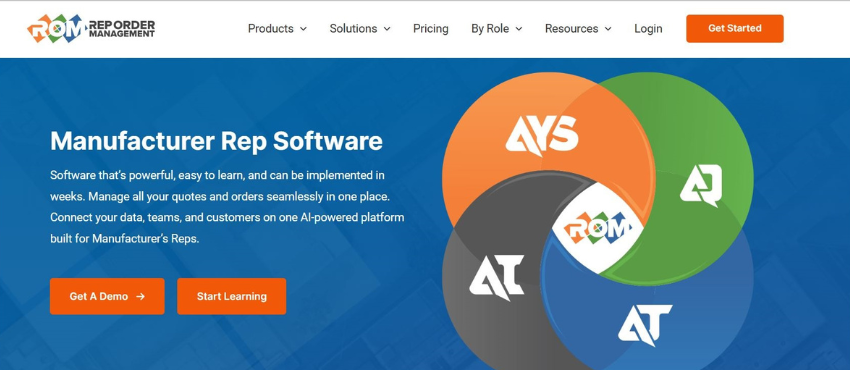Spreadsheets weren’t built for quoting. Yet thousands of manufacturer rep firms still rely on them to manage complex bids, track job volume, and send pricing to customers, often across dozens of manufacturers and fast-moving timelines. It feels familiar. It’s flexible. And it works, until it doesn’t.
The hidden cost of spreadsheet-based quoting isn’t just in formatting issues or formula errors. It’s in the hours lost chasing down updates, the bids missed due to version conflicts, and the lack of insight that comes from working in silos. For sales teams trying to move faster and win more jobs, these inefficiencies pile up fast.
- Why Spreadsheets Still Dominate Quoting Workflows
- The Hidden Costs No One Talks About
- Real-World Spreadsheet Mistakes That Made Headlines
- Why the Risk Is Higher for Manufacturer Reps
- What a Purpose-Built Quoting System Solves
- How ROM Eliminates Spreadsheet Headaches
- The Cost of Inaction Is Higher Than You Think
In this post, the hidden cost of quoting with spreadsheets: why it’s time to upgrade, we’ll break down the real risks of spreadsheet quoting, from time waste and data errors to missed revenue opportunities, and show why upgrading to a purpose-built quoting platform isn’t just a tech decision. It’s a business strategy.

Why Spreadsheets Still Dominate Quoting Workflows
Most rep firms didn’t choose spreadsheets as a long-term solution, they fell into them. Excel and Google Sheets are widely accessible, easy to manipulate, and already embedded in daily operations. When you’re quoting across dozens of manufacturers and constantly adjusting specs, a blank spreadsheet feels like freedom.
But what starts as a quick fix often becomes the default. Over time, that simple pricing sheet evolves into a bloated document with fragile formulas, inconsistent formatting, and undocumented logic. Teams adapt around it. Sales reps build their own versions. And what once felt efficient becomes hard to scale and even harder to manage.
Familiarity can create a false sense of control. Just because you understand how the sheet works doesn’t mean it’s working for the business. Spreadsheets don’t enforce pricing logic. They don’t alert you to errors. And they don’t help you understand what’s really happening across your quoting pipeline.
The reality is, spreadsheets are easy to start with, but difficult to standardize, difficult to govern, and nearly impossible to optimize for long-term growth.

The Hidden Costs No One Talks About
Quoting with spreadsheets comes with no licensing fees, no user logins, and no onboarding. But that surface-level simplicity masks the real costs, ones that compound as your team grows and your quoting process gets more complex.
Time Waste Across the Sales Team
Manual quoting doesn’t just take longer, it multiplies inefficiencies across the entire sales operation. Reps spend hours copying and pasting between files, chasing approvals, or searching for the latest version. When updates are made by email, the likelihood of working off outdated pricing increases with each email update.
These aren’t just administrative delays. They create friction at every step of the sales process and often result in slower turnaround times. In competitive bidding environments, speed matters. Delays cost deals.
Error Rates and Data Risk
According to a 2024 study, 94% of business spreadsheets contain critical errors. That’s not a rounding issue, it’s a systemic risk. A single misaligned cell, a forgotten formula, or a copy-paste mistake can skew pricing, damage credibility, or trigger costly rework. These aren’t rare incidents. They’re embedded in the daily quoting process, hidden under layers of formatting that no one questions until it’s too late.
Operational Inefficiency
When quotes aren’t centralized, teams lose time not just creating them, but managing them. There’s no global view of what’s pending, what’s been approved, or where opportunities are stalling. Sales managers can’t coach, leadership can’t forecast, and reps can’t focus on selling. The process becomes reactive instead of repeatable.
Lack of Insight for Sales Leadership
Spreadsheets weren’t designed to show trends. They’re static, siloed, and disconnected from real-time performance metrics. There’s no way to answer questions like:
- Which manufacturers are driving the most quoting activity?
- What’s our average quote-to-order conversion rate?
- Are we winning fast, or just quoting a lot?
Without those answers, leadership is left guessing, and growth suffers as a result.

Real-World Spreadsheet Mistakes That Made Headlines
Spreadsheet errors aren’t just an internal inconvenience. In high-stakes environments, they’ve led to public embarrassment, regulatory issues, and billions in financial loss. The same risks apply, at scale or in a rep firm with just a few quoting team members. Here are some of the most widely cited spreadsheet failures:
J.P. Morgan Chase – $6 Billion Loss
In 2012, a copy-paste mistake buried in a risk model spreadsheet contributed to a trading loss of $6 billion. The issue? An Excel formula used for value-at-risk calculations was flawed, and no one caught it in time.
TransAlta – $24 Million Loss
This energy company lost $24 million due to a simple Excel input error that shifted rows in a bidding spreadsheet. One mistake, and they overpaid for electricity transmission contracts they didn’t intend to purchase.
Barclays – Financial Crisis Fallout
During the 2008 financial crisis, Barclays relied on spreadsheets with hidden rows and formatting issues. When the data was misinterpreted, it led to the acquisition of unwanted liabilities, costing the bank millions.
UK Test and Trace – 15,841 COVID-19 Cases Omitted
In 2020, nearly 16,000 positive COVID-19 cases were excluded from England’s contact tracing system because the Excel files used had reached their row limit. The impact was national, public health risk, media backlash, and loss of public trust.
These are big numbers from big names, but the underlying problem is familiar. The overreliance on spreadsheets in mission-critical workflows. For manufacturer reps quoting across product lines, price books, and projects, errors may not make headlines, but they still hurt your bottom line.

Why the Risk Is Higher for Manufacturer Reps
For most businesses, quoting errors are costly. For manufacturer reps, they’re critical. That’s because the quoting environment rep firms operate in is more complex, more variable, and more time-sensitive than most internal sales teams will ever encounter.
- Multi-Manufacturer Complexity: Reps don’t sell one product line. They manage quoting across multiple manufacturers, each with its own pricing structure, rules, and exceptions. A spreadsheet may start with accurate pricing, but once it’s duplicated or edited for a different manufacturer, mistakes become inevitable.
- Customization at the Job Level: Every job site is different. Whether it’s HVAC equipment for a school, hospital, or government facility, each quote must account for different specifications, configurations, and terms. Managing that level of variation manually increases the chance of quoting inconsistencies and lost credibility with customers.
- Speed Is Non-Negotiable: In competitive bid environments, speed wins. The first rep to deliver a clean, accurate quote is often the one who wins the order. Spreadsheets slow everything down, especially when they require multiple approvals, version tracking, or formatting cleanup before sending.
- Reputation Is Everything: Reps don’t just sell. They represent manufacturers in the field. One mistake in pricing or delivery can reflect poorly on both the rep firm and the brand they represent. That reputational risk compounds every time a spreadsheet introduces avoidable errors.
This isn’t about whether spreadsheets are usable. It’s about whether they’re defensible, at scale, under pressure, and across a portfolio of manufacturers. For most rep firms, that answer is quickly becoming “no.”

What a Purpose-Built Quoting System Solves
Spreadsheets were never designed for sales. They lack audit trails, permission controls, error-proofing, and real-time collaboration. That’s where purpose-built quoting systems outperform, by design.
A quoting platform built for manufacturer reps centralizes all product data, pricing, and manufacturer terms in one location. No more hunting through old folders for the latest Excel file or copying data from outdated templates. Instead, users get up-to-date pricing, consistent formatting, and built-in validations that prevent common errors before they happen.
Automation also plays a significant role. With a quoting system, reps can generate complex, multi-manufacturer quotes in minutes, not hours. Product rules, upsell logic, and discount structures can be baked in, ensuring accuracy even when quoting under tight deadlines.
Permissions and collaboration tools add further advantages. Sales managers can review quotes before they go out. Teams can access real-time status updates. And leadership gains visibility into what’s being quoted, to whom, and for how much, data that spreadsheets can’t surface without hours of manual work.
The result is more than time saved. It’s fewer mistakes, faster response times, and a stronger chance of winning the job. Most importantly, it’s a shift from reactive quoting to a proactive, scalable sales process.

How ROM Eliminates Spreadsheet Headaches
Rep Order Management (ROM) was built to replace the chaos of spreadsheets with structure, clarity, and speed. Instead of manually updating rows, columns, and formulas, teams using ROM gain access to a centralized quoting and ordering system that minimizes errors and maximizes accuracy.
- Improved Accuracy: Every quote, order, and manufacturer detail lives in one clean interface. No more broken formulas, version confusion, or copy/paste risks.
- Faster Workflows: With automation built into the quoting process, reps can generate accurate bids in a fraction of the time it takes in Excel, freeing them to focus on relationships, not recalculations.
- Customer Service Confidence: Sales teams gain full visibility into job status, pricing, and history, ensuring they can answer customer questions quickly and confidently.
- Full Transparency for Executives: Leadership teams no longer have to chase down updates or decipher spreadsheets. With ROM, reporting and forecasting are built in, giving them instant access to real-time business insights.
ROM doesn’t just replace spreadsheets, it future-proofs your quoting process. For rep firms serious about eliminating costly errors, speeding up quote turnaround, and improving customer experience, it’s time to close the spreadsheet and open ROM.
The Cost of Inaction Is Higher Than You Think
Spreadsheets were never designed to be the backbone of a modern sales operation, especially in the high-stakes, fast-paced world of manufacturer reps. Every manual entry, formula error, or version mix-up chips away at margins, trust, and time. While the financial losses can be staggering, the hidden toll on customer experience, team morale, and strategic growth is just as damaging.
The transition away from spreadsheets isn’t just a technical upgrade; it’s a strategic necessity. As quoting complexity grows, so does the risk of letting outdated tools run your business. It’s not a matter of if your team will outgrow spreadsheets, it’s when the cost becomes too high to ignore.
ROM Was Built to Meet That Moment
With streamlined quoting, built-in accuracy checks, and full visibility across the sales cycle, ROM empowers teams to win more bids, without the baggage of outdated tools. If your sales team is still clinging to spreadsheets, it might be costing you more than you realize. It’s time to move forward with ROM. Schedule a demo to see ROM in action.

